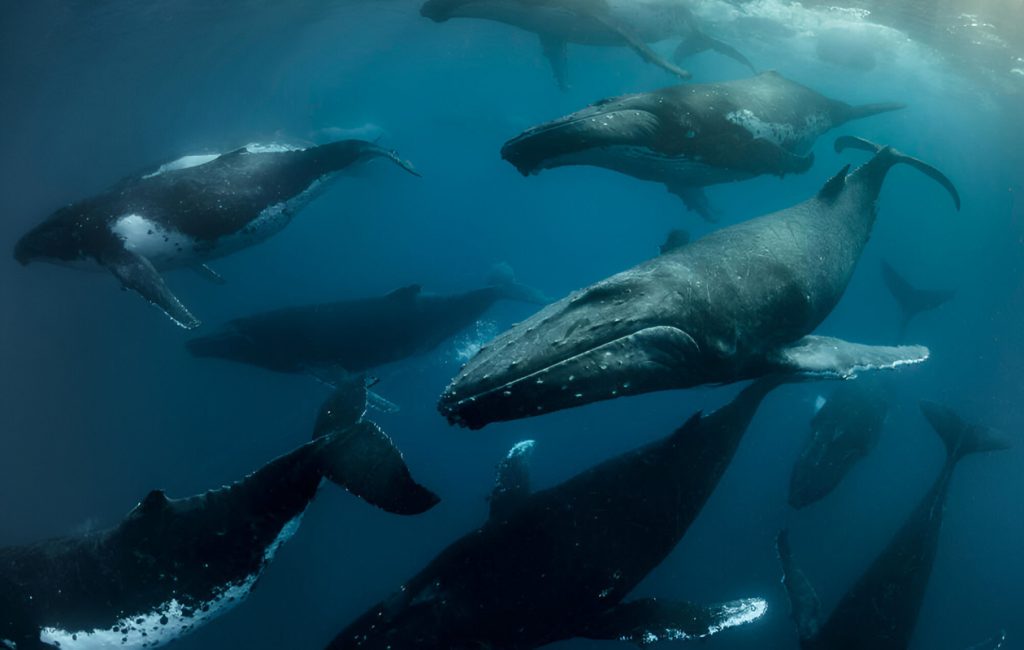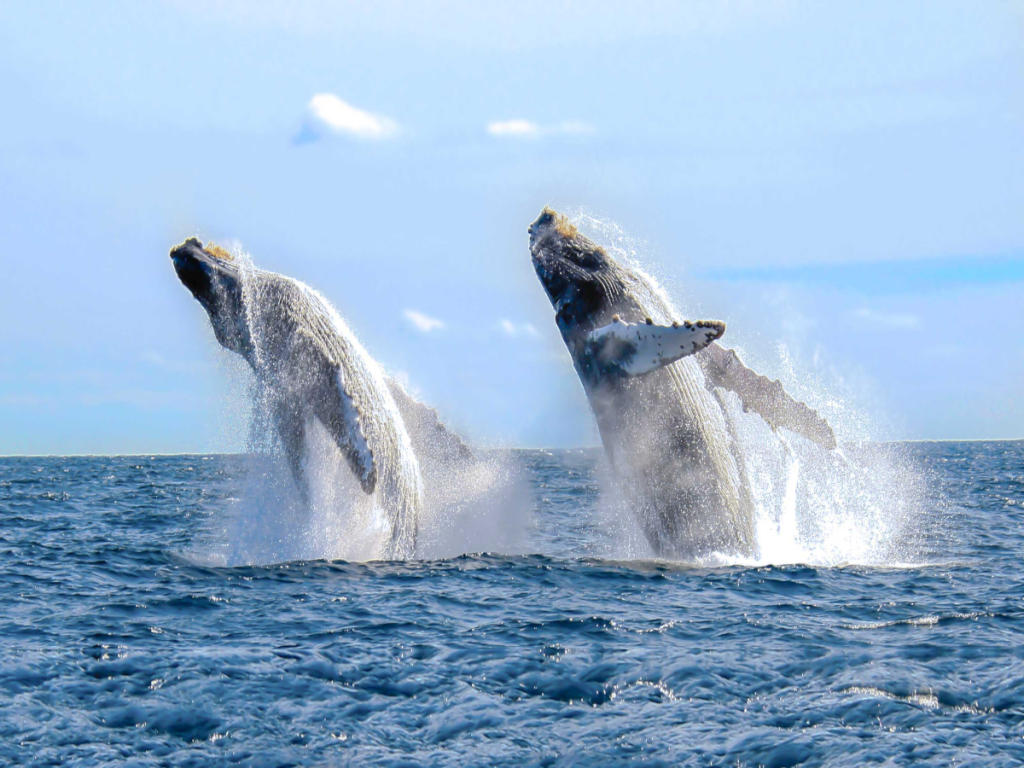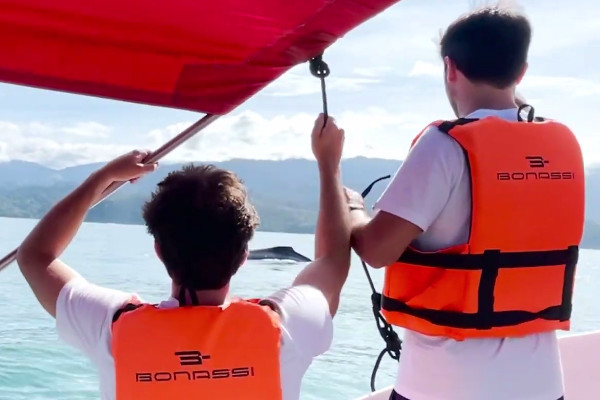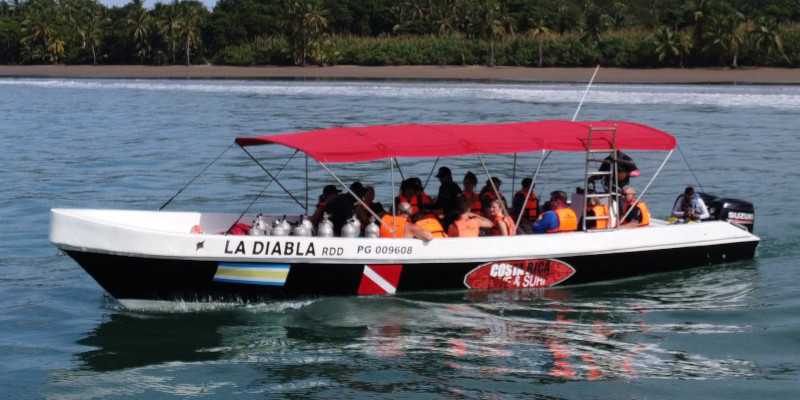Costa Rica is a paradise for nature lovers, and among its most impressive natural spectacles is the sighting of humpback whales. Seeing whales in Costa Rica is a unique experience that no tourist or local resident should miss.
This phenomenon can be witnessed almost all year round thanks to the migration of different whale populations that choose our warm waters as a place to reproduce. Watching these ocean giants leap, sing, or swim freely is a breathtaking experience that leaves a lasting impression.
Below, we’ll tell you everything you need to know to plan your encounter with these incredible marine creatures.
Where do humpback whales come from?

Hundreds of whales travel each year from both the northern and southern hemispheres and meet in Costa Rica to feed and reproduce.
The humpback whales that visit Costa Rica travel thousands of kilometers in one of the longest migrations in the animal kingdom. There are two major populations that arrive at different times of the year: one comes from the northern hemisphere (mainly California and Alaska), and the other from the southern hemisphere (from Antarctica and Patagonia).
Both groups migrate to our coasts to mate and give birth in warmer, calmer waters. This great whale migration to Costa Rica is vital for their life cycle, and our country—especially the South Pacific—is one of the few places in the world where both populations overlap.
Fascinating whale behavior

During whale-watching tours, it’s common to witness unique behaviors of humpback whales. Their iconic breaches—when they leap out of the water—are stunning, not only due to the size of the animal, but also because of their sheer beauty. They also slap the surface with their fins or tails, which scientists believe may be a form of communication.
One of the most astonishing manifestations is their song. Male whales produce long, complex vocalizations that can last up to 30 minutes and repeat in patterns that vary by region. These humpback whale songs continue to be the subject of scientific research and still raise many questions today.
Surprising facts that will amaze you
Humpback whales in Costa Rica are not only impressive in size, but also in their behavior. One of the most surprising stories is that of a whale that supposedly saved a marine biologist from a shark by covering her with its body. While it’s hard to prove the intention behind such behavior, stories like this have led some scientists to explore the possibility of interspecies empathy.
In addition, learning about the work of those who interact with these creatures daily—such as marine biologists in Costa Rica—allows us to better appreciate the complexity and beauty of the marine world.
When is the best time to see whales in Costa Rica?

Costa Rica offers the unique advantage of receiving humpback whales from both hemispheres, which makes it possible to see them for most of the year. The two main seasons are:
- July to November: southern hemisphere whales arrive to give birth in warm waters. This is the best time to see Whales in Costa Rica
- December to March: northern hemisphere whales arrive to reproduce.
The best time of day to see whales in Costa Rica is in the morning, when the ocean is calmer, the light is ideal, and the weather is more predictable. However, afternoon tours can also be quite successful, especially on clear days.
Where to see humpback whales in Costa Rica?
The best whale-watching spots in Costa Rica are found in the South Pacific, a region rich in natural beauty and marine biodiversity. Some of the most notable locations include:
- Marino Ballena National Park (Uvita): famous for its natural “whale tail” formation visible at low tide.
- Drake Bay: part of Corcovado National Park, ideal for combining jungle and marine excursions.
- Golfo Dulce: a deep tropical gulf where whales find calm and protection.
- Caño Island: during whale season, there’s a chance to spot whales while diving or near the island.
These areas not only offer high chances of sightings but also stunning scenery and well-organized tourist services.
Safety and sustainability
The well-being of humpback whales must always be a priority. In Costa Rica, there are regulations that responsible tour operators must follow: keeping a safe distance, not chasing the animals, limiting the number of boats near a group of whales, and avoiding disruption of their natural behavior.
Approaching whales in the water or attempting to swim with them is strictly prohibited—for their safety and yours.
At Costa Rica Dive and Surf, we strictly follow all guidelines and educate our visitors on how to enjoy a safe, ethical, and respectful experience. We offer thrilling tours without compromising the whales’ well-being.
Which operator should you choose?

Costa Rica Dive and Surf is one of the leading marine tour operators in Costa Rica’s South Pacific. Based in Uvita, we operate within Marino Ballena National Park, the country’s premier whale-watching destination.
Our certified guides are trained to offer not just an exceptional whale tour, but an educational and transformative experience. Our boats are comfortable and safe, and our tours are designed to maximize sightings with minimal environmental impact.
What to bring (and what not to)
To make the most of your experience, we recommend bringing:
- Biodegradable sunscreen
- Light, comfortable clothing
- A hat or cap
- A camera with good zoom (or binoculars)
- A reusable water bottle
Avoid bringing single-use plastics, objects that may blow away in the wind, or noisy devices that could disturb the environment. You’ll find a more detailed packing list on our tour page.
How to protect them? How can you help?
Humpback whales face many global threats, including noise pollution, marine plastic waste, and ship strikes.
As visitors, we can make a difference by choosing responsible tour operators, avoiding littering, and always respecting the minimum observation distance. Simple actions—like reducing plastic use and staying informed about conservation—can have a big impact.
An experience you’ll never forget
Seeing a humpback whale in its natural environment goes far beyond a typical excursion—it’s a privilege and a deep connection to the ocean.
In Costa Rica, this experience is possible, accessible, and above all, transformative. We invite you to enjoy it with respect, awareness, and wonder.
Book a tour for you and your family today and experience the Whales in Costa Rica!
